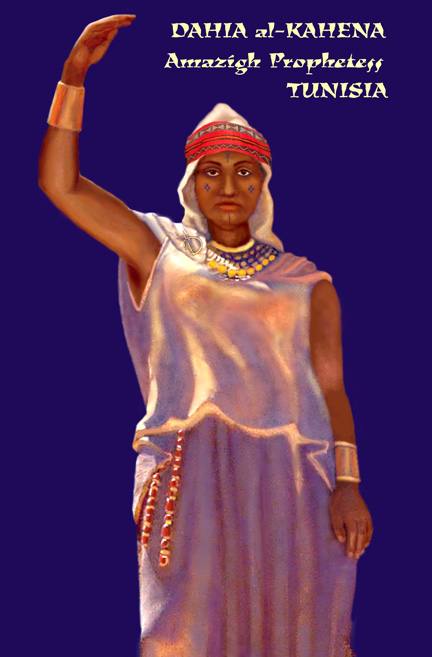Dahia al-Kahina
Amazigh prophetess, Tunisia, 640-703 CEMax Dashu
Dahia or Dihia al-Kahina was the daughter of an Amazigh (“Berber”) chieftain in the Aurès mountains, on the border of modern Tunisia and Algeria. She is known by various names: Dihya, Diah, Dhabba, or Dihya Tadmayt, “beautiful gazelle.” A 1377 account by Ibn Khaldun calls her Dihya al-Kahina, a title which means “prophetess, sorceress” in Arabic (and is related to kohenet, the Hebrew word for “priestess”.)
Writing over 600 years after her death, the Arab historian described Dihia as a tall woman with long hair. She was the daughter of a Jerawa chieftain, and she was said to have ruled the tribe for 35 years from the capital Baghaya. Ibn Khaldun records her as being Jewish, though most modern sources, including the Jewish Encyclopedia, see her as pagan, though some suggest she was Christian because of Byzantine rulership of the region. The prophetess was a mature woman, a widow with two sons, at the height of her power.
When the Arab army of Hassan ibn al-Nu’man invaded and occupied Carthage in 695, she united the Amazighen over a vast territory to resist. She became queen of Numidia (which the Arabs called Ifriqiya, the origin of our word Africa.) Dahia defeated his army decisively in several battles, forcing him to retreat back to Libya.
Three years later he returned with a bigger army. She used a scorched earth policy to beat them back, but this strategy turned many of the farmers against her. Dahia held the resistance for four years. Her army was overcome in 701, but she fled to the hills. Toward the end, she prophesied her own defeat and urged her sons to escape to the other side so that they could survive. She later died in battle near Tabarka, around 703 CE. The Amazigh resistance ended with her, at least for that time.
But Sufi seeresses played a part in modern Amazigh insurrections against foreign rule. One of them was Lalla Fatma N’Soumer of Algeria. This excerpt from “Lalla Fatma N’Soumer: A Symbol of Feminine Strength” tells a bit of her story: https://www.algeria.com/blog/lalla-fatma-nsoumer-a-symbol-of-feminine-strength/"The title Lalla is given to women who are considered saints or of a high ranking, much like the title Sidi for men. From the start Lalla Fatma N'Soumer proved to be a force to be reckoned with, a girl with her own way of thinking and in later years a woman that was revered by others and became a legendary figure. Lalla Fatma N'Soumer became synonymous with the Kabyle Resistance Movement and was a key figure in the fight against the French invasion of Algiers. [https://www.algeria.com/blog/lalla-fatma-nsoumer-a-symbol-of-feminine-strength/]
"It is estimated that Fatima N'Soumer was born in July 1830, and did have siblings, although the number is not determined. It is known that her father was a Koranic school director. She insisted on sitting in on her father’s lessons and working on her education, which was very unusual for a girl to do at that time. In line with their culture, a wedding was arranged for her at the age of sixteen, which she refused, rather adopting a solitary life and continuing her religious studies.” (So, she was a marriage resister.)
"It was not long before people heard that N'Soumer could look into her own future, and many came from far and wide with gifts and asking for her advice. What most people noticed first is how well she took care of herself and her striking features.
"The French began to move into Algerian territory in 1830, ... Lalla Fatma N’Soumer was able to inspire men through her speeches and was present at many battles. Tragically, Bou Baghla was killed in 1854 and the resistance remained without a leader until 1855, when it was decided to hand leadership over to Fatma N'Soumer, with the assistance of her brothers.
"The resistance was to be overwhelmed in 1857, outnumbered by the French army. Many, including Lalla Fatma N'Soumer, were forced to go into hiding, although she was the last to surrender. Stories on how her capture came about are based on speculation, but she was found, arrested and taken prisoner by the French. The Daughters of Lalla Fatma N’Soummer, a feminist organization, was named after her and her fearlessness, independence and bravery is still alive in songs and depictions in the country. In 1995, her remains were moved and reburied in El Alia, Algiers, the heroes' cemetery."
Other prophetesses:
Essie Parrish, yomta and Bole Maru Dreamer, Kashaya Pomo, Stewarts Point, California
Muhumusa, exiled Rwandan queen, oracle of Nyabingi in Uganda
Mauricia la Bruja, prophetess of the Old Ways, Venezuela
Teresa Urrea, la Santa de Cabora, healer and revolutionary seeress, Sonora, Mexico, El Paso, Texas, and Clinton, Arizona.
Libuše, prophetess, tribal judge, and founder of Prague, Czechia
Pau, kaula wahine / seeress, Hawai'i
The poster is 18 x 24 inches on high quality heavy stock.
Gift. Pay shipping only for one copy ($4 in USA, $14 to all other countries).
Order here. To pay securely with your credit card, look for the gray Checkout button (beneath the yellow Paypal button.)
More on Prophetic Women
Home | Catalog | Articles | Secret History of the Witches
